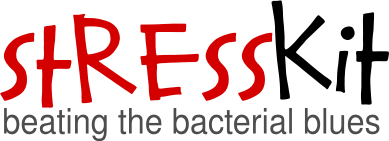Team:IIT Madras/Project
From 2008.igem.org
Sayashkumar (Talk | contribs) |
Sayashkumar (Talk | contribs) |
||
| Line 7: | Line 7: | ||
!align="center"|[[Team:IIT_Madras/Notebook|Notebook]] | !align="center"|[[Team:IIT_Madras/Notebook|Notebook]] | ||
|} | |} | ||
| - | |||
| - | === | + | ===Stress=== |
| - | + | Living organisms, like E.Coli, adapt and gear themselves to environmental changes. They are in the constant process of modifying their proteome based on the changing requirements. An interesting question arises as to how exactly does a bacteria gain awareness of its environment and what mechanisms do they use to deal with it? | |
| - | + | The first step of gene expression is transcription, carried out by a protein called RNA Polymerase. This multi-subunit complex confers multiple particularities to the process of transcription allowing it to carry out different functional roles. One of the subunits, the sigma subunit, lends sequence specificity to the complex for recognizing relevant parts of DNA, called promoter regions. Only on the successful binding of this sigma subunit with a compatible promoter sequence does the process of transcription initiation occur. | |
| - | + | ||
| - | + | ||
| - | + | ||
| - | + | ||
| - | + | Bacteria make use of multiple sigma subunits to partition its genome into different programs. E.Coli, for example, organizes its genome using 6 sigma factors which help the organism survive in different environmental niches. It's also observed that organisms which exhibit a greater diversity in their living conditions make use of a higher number of sigma subunits. This would provide for an adaptive advantage in settling into tougher and tougher niches. | |
| - | + | The different sigma subunits present in E.Coli are as follows, | |
| + | * σ<sup>70/D</sup> (rpoD):housekeeping genes during exponential growth | ||
| + | * σ<sup>54/N</sup> (rpoN):nitrogen starvation response | ||
| + | * σ<sup>38/S</sup> (rpoS):master regulator for a generalized stress response | ||
| + | * σ<sup>32/H</sup> (rpoH):unfolded protein response | ||
| + | * σ<sup>28/F</sup> (rpoF):flagellar biosynthesis | ||
| + | * σ<sup>24/E</sup> (rpoE):response to unfolded proteins in the cell envelope | ||
| - | === | + | ===Chosen Genes=== |
| - | |||
| - | == | + | ===Design of Promoters=== |
| + | Our design strategy for the promoters took into consideration the regulatory diversity of the promoters, employing the use of distal, proximal and trans regulatory elements. Also, an important point to consider is that these promoters are in an 'always-on' state by default. They are constitutively expressed subject to a few environmental conditions. | ||
| - | + | We overcome these constraints by experimenting with a new style of 'synthetic promoter' where we fuse sigma factor recognition sequences into a lac promoter. This takes away the 'always-on' issue with our promoters and also places them under the convenient regulation of IPTG. These hybrid/engineered promoters were designed in a way to preserve as much of the consensus sequence while maintaining the lac repressor binding sites. | |
| - | + | ||
| - | + | ||
| - | + | ||
| - | + | ||
Revision as of 04:55, 20 August 2008
| Home | About Us | Project Details | Notebook |
|---|
Stress
Living organisms, like E.Coli, adapt and gear themselves to environmental changes. They are in the constant process of modifying their proteome based on the changing requirements. An interesting question arises as to how exactly does a bacteria gain awareness of its environment and what mechanisms do they use to deal with it?
The first step of gene expression is transcription, carried out by a protein called RNA Polymerase. This multi-subunit complex confers multiple particularities to the process of transcription allowing it to carry out different functional roles. One of the subunits, the sigma subunit, lends sequence specificity to the complex for recognizing relevant parts of DNA, called promoter regions. Only on the successful binding of this sigma subunit with a compatible promoter sequence does the process of transcription initiation occur.
Bacteria make use of multiple sigma subunits to partition its genome into different programs. E.Coli, for example, organizes its genome using 6 sigma factors which help the organism survive in different environmental niches. It's also observed that organisms which exhibit a greater diversity in their living conditions make use of a higher number of sigma subunits. This would provide for an adaptive advantage in settling into tougher and tougher niches.
The different sigma subunits present in E.Coli are as follows,
- σ70/D (rpoD):housekeeping genes during exponential growth
- σ54/N (rpoN):nitrogen starvation response
- σ38/S (rpoS):master regulator for a generalized stress response
- σ32/H (rpoH):unfolded protein response
- σ28/F (rpoF):flagellar biosynthesis
- σ24/E (rpoE):response to unfolded proteins in the cell envelope
Chosen Genes
Design of Promoters
Our design strategy for the promoters took into consideration the regulatory diversity of the promoters, employing the use of distal, proximal and trans regulatory elements. Also, an important point to consider is that these promoters are in an 'always-on' state by default. They are constitutively expressed subject to a few environmental conditions.
We overcome these constraints by experimenting with a new style of 'synthetic promoter' where we fuse sigma factor recognition sequences into a lac promoter. This takes away the 'always-on' issue with our promoters and also places them under the convenient regulation of IPTG. These hybrid/engineered promoters were designed in a way to preserve as much of the consensus sequence while maintaining the lac repressor binding sites.
 "
"
